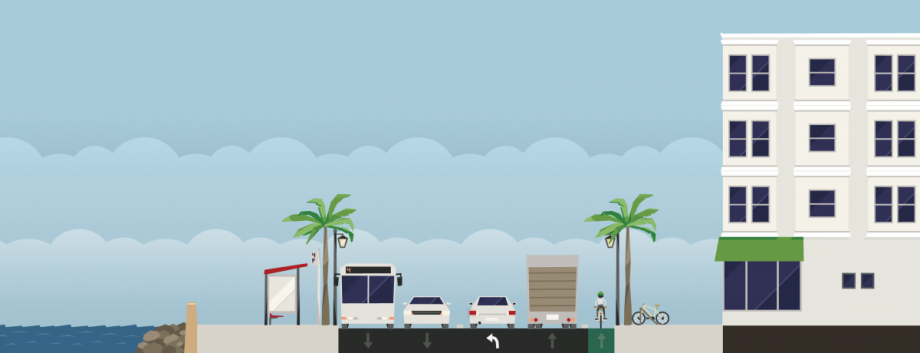Almost every planner has the fantasy at least a few times a career: The wish to lift up different parts of a given street and, like some all-powerful deity of traffic engineering, rearrange them to your liking. Imagine installing a bike lane with a snap of the fingers, or widening a sidewalk with the wave of a hand.
A new app from the civic-minded techies at Code for America lets you live out this godlike scenario, at least virtually.
Launched in beta last week, Streetmix invites users to mix and match sections of a hypothetical street, with options for driving and turning lanes, bus lanes, bike lanes and bike racks, streetcars, sidewalks, parking, trees, parklets and benches, and even wayfinding signs.
Each of these amenities takes up a certain amount of space, of course, but the app gives a lot of leeway. You can expand lanes and sidewalks to ridiculous widths, or change the size of the street to allow more room for another tree or bench. Looking for an easy start? Make the avenue a generous 80 feet wide. Up for a challenge? Shrink it down to 40 feet.
There are other nifty features, too. You can change the environment that flanks your street, filling it with commercial or residential building, or opting for a waterfront on one side, or taking the cynical route and turning it into a vacant lot.
But the purpose behind Streetmix isn’t only to provide a platform for messing around. As Code for America’s Lou Huang explained in a phone interview, the real aim is to better engage citizens in the planning process.
The app’s value lies in making it easy to visualize proposed changes to a street. The consequences of implementing an extra parking lane, for example, become much more apparent when you can actually see how it would fit into the streetscape. City residents can use Streetmix to show planning officials just what, exactly, they want their streets to look — or why they are coming out against a planning project.
“We… have already started getting a ton of people who’ve created streets and started conversations around the ideas generated from them,” Huang, who pitched the Streetmix project in January, wrote in an email. The idea came from a public meeting in San Francisco, during which citizens were asked to represent their ideal outcome for the Great Second Street project using paper cutouts.
Huang took that concept and made it digital. In a blog post on the CfA website, Huang wrote how the app has already been applied to real-world situations in such cities as Seattle, Albuquerque and Auckland, New Zealand. By phone he mentioned that CfA has heard interest from officials in Fort Worth, Raleigh, Mexico City and a bevy of Canadian cities like Toronto, Vancouver, Edmonton and Calgary.
In addition to giving citizens a more expedient way to communicate their wishes to planners, Streetmix can also serve as a learning tool. As you may imagine, making all your urbanist wet dreams a reality becomes much trickier when considering the limitations of a real, concrete street. While playing around online you can choose to ignore them. But other users may tell you why having two bike lanes 15 feet in width might not cut it with a city planner.
“Our strategy is to manage by influence,” Huang said. “If you do something really stupid, we won’t say ‘no,’ but we may tell you why you can’t do it.”
But if you just want to use the app to let your fantasies run wild, that’s cool, too.
















